Yesterday, the FAA (Federal Aviation Administration) handed down its final regulations for unmanned aerial vehicles, a.k.a. drones. The new rules are hailed as an improvement to safety, security, and accountability for and by recreational and small business pilots; but they're also paving the way for widespread corporate use for things like package delivery, data collection, and other industrial uses.
There are a few things to unpack from the new rules, not to mention some important changes to past proposals, and they will have some far-reaching effects despite changing relatively little. Many of the new rules are orchestrated around opening the road to automated and utilitarian purposes like package deliveries, but they're also going to set new restrictions and grant a couple allowances to independent drone operators.
Remote ID
Remote ID has been anticipated for about two years as a key security and safety addition for drones. It functions a bit like the transponder in an airplane by broadcasting its presence for others to detect. This can allow towers, planes, and law enforcement to detect the presence of drones and respond if they are a danger to people or used to commit crimes. The Association for Unmanned Vehicle Systems International has described this as a "digital license plate for drones."
Compliance with the Remote ID requirement dictates that drones must broadcast unique identification, current location of the drone, and the take-off location or location of the operator. Notably, Remote ID is not required on drones weighing less than 0.55lbs (250g), which includes ultralight models like the DJI Mavic Mini — unless they are going to fly over people, which still requires Remote ID.
When the new rules are officially published in January, drone manufacturers will be given 18 months to add Remote ID to any models currently for sale. Drone operators will get an extra 12 months (for a total of 30 months) to equip Remote ID on any drone that doesn't have it built-in. In other words, if you currently own a drone or buy one that doesn't already comply with the new regulations, it will require an external Remote ID module by July 2023.
These rules are a significant reversal from an early 2020 proposal that would have required all drones to network with a "Remote ID service" operated by a private company. If it had been formalized, this regulation would have necessitated that drones maintain an internet connection at all times, and all of their flight logs would be stored for no less than six months. DJI, the largest manufacturer of consumer drones in the world, pushed back against this proposal and highlighted its own early work to support a simple broadcast system. Due to these early efforts, it looks like some of DJI's existing models are likely already compliant with the new regulations.
Flying over people and moving vehicles
Drone pilots in the US should already be familiar with the current FAA regulations for flights. In short, a drone is only allowed to fly over people if they are directly involved in its flight (e.g. pilot and camera operator), the people are under sufficient physical cover to protect them if the drone falls (e.g. inside a building or a stationary car), or if the FAA has given a special waiver to the pilot. Similar rules also exist for flights that would put a drone above moving vehicles.
Don't worry, the original regulations aren't going away, but the FAA is carving out narrow allowances to give a few opportunities to fly over people without obtaining a waiver, assuming the proper steps and safety precautions are taken. The basic requirements are:
- Drones must not have any exposed spinning parts (i.e. propeller blades) that can cut people. In other words, you must have prop guards.
-
Must either weigh less than 250g or have a method of insuring that a falling drone does not transfer more than 11 foot-pounds of ridged force upon impact with a person.
- Note: This rises to 25 foot-pounds while flying over a restricted-access area and all occupants are informed that an unmanned drone is flying overhead.
There is another allowance for specially licensed and maintained drones under part 21.
With regards to vehicles, the same basic rules apply; however, drones are not allowed to hover above vehicles unless they're in a restricted-access area and all drivers in that area are aware of the drone. Alternatively, drones may also fly over vehicles if it is purely for the purpose of transit and they do not remain hovering above moving vehicles. Feel free to insert "why did the drone cross the road" jokes below in the comments.
Flying at night
The FAA has already had rules for nighttime flights that require sufficiently visible lighting at all times, but they were never particularly specific or fully enforceable. The rules haven't been substantially altered, but they've been more precisely codified. Now aircraft must have anti-collision lights that can be seen for 3 statute miles — and those lights must be operational, of course. Also, pilots must take an updated initial knowledge test online before engaging in flights after dark.
Testing
Finally, the new regulations make a subtle point that small drone operators will also have to complete updated training that includes details about flying at night. Current regulations simply require pilots to take a test every 24 months. It sounds like pilots will have 60 days after final publication of these rules to take the updated training, but it's not entirely clear if this is only necessary for nighttime flights or if it's compulsory for everybody. In either case, the training can be completed online at no cost. I'm sure there will be an email from the FAA when the time comes.
To get all the details, you can read the massive 292-page document from the FAA, or just check out the summary for flying over people. There is also a separate 460-page document for Remote ID.
Source: FAA

